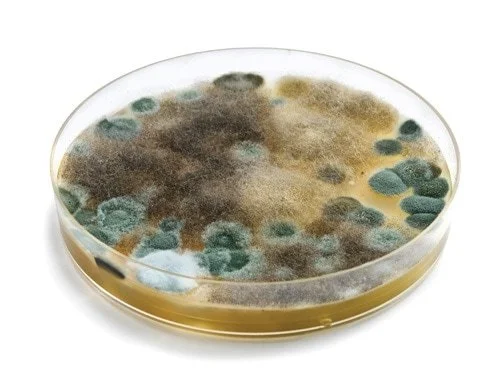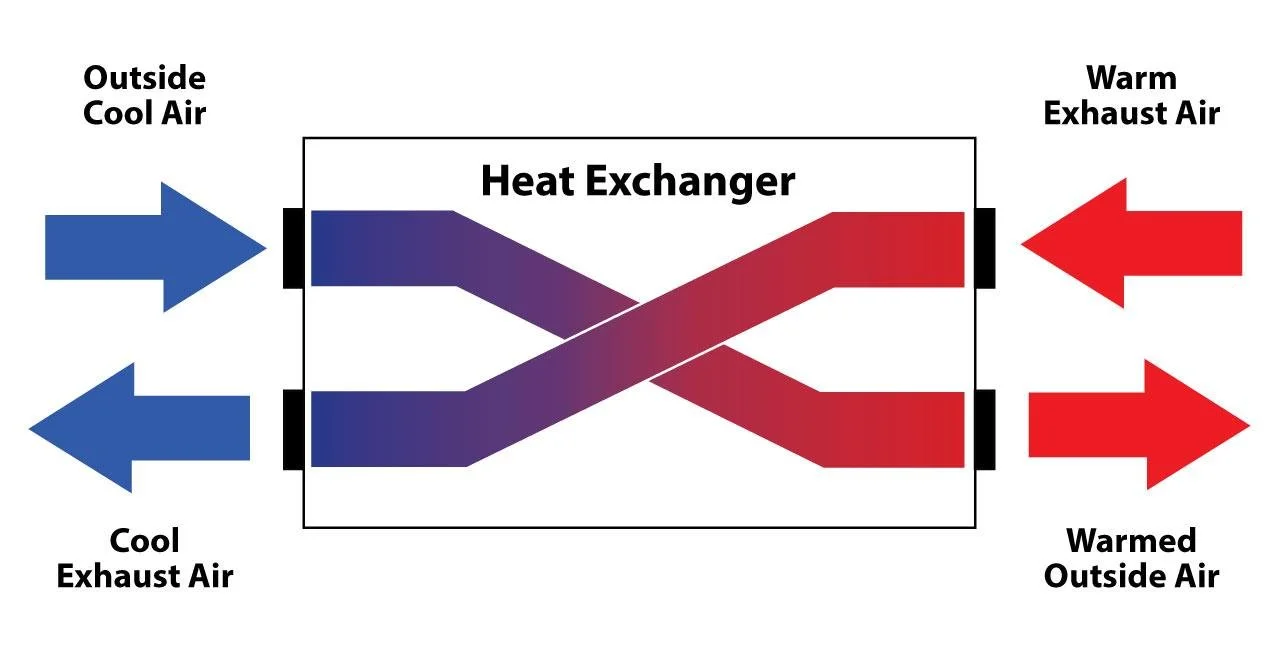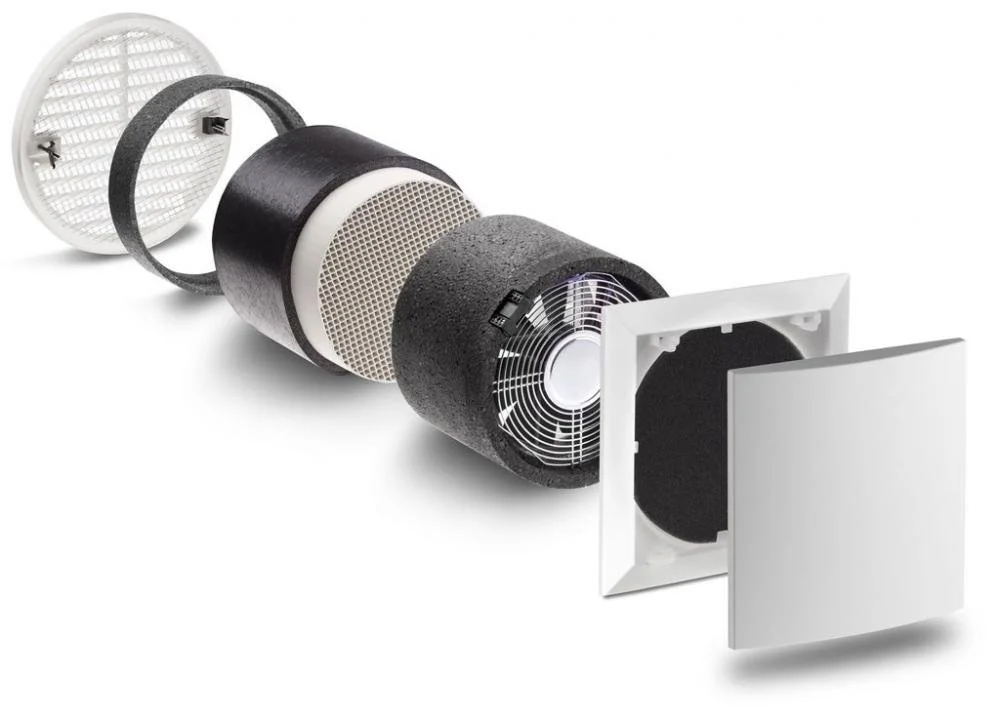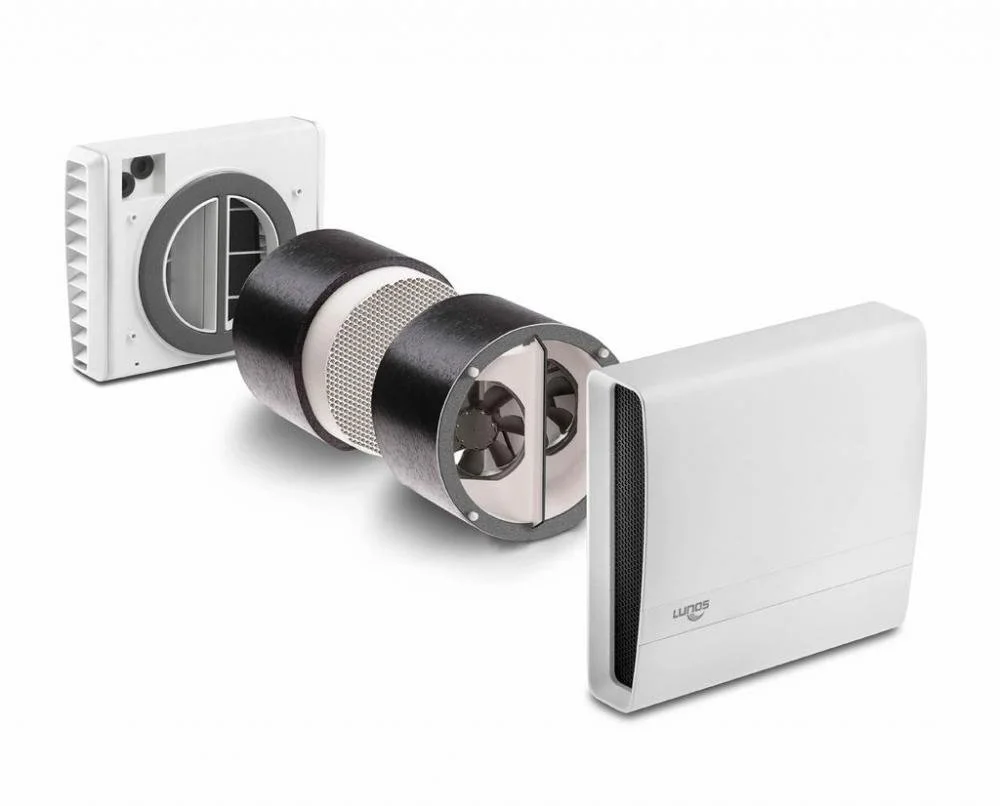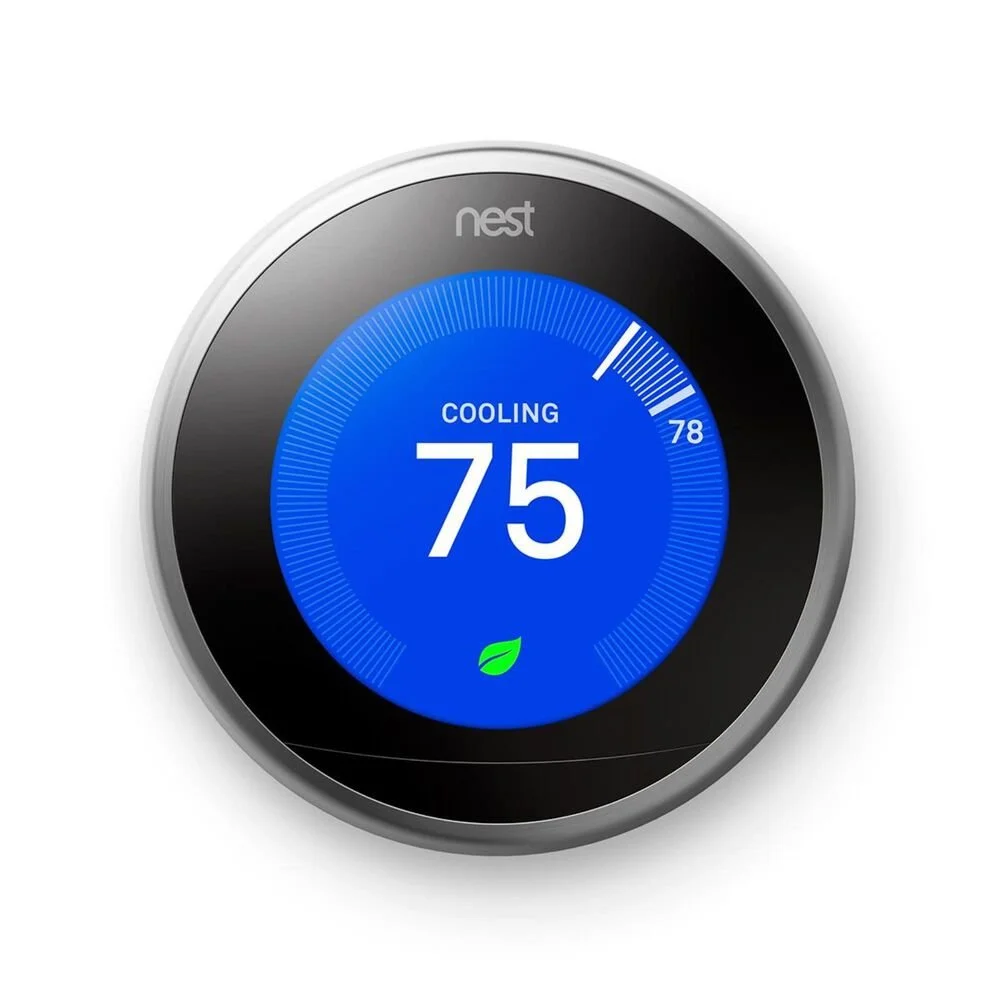TINY OFF-GRID HOUSE AIR FILTRATION & MECHANICAL VENTILATION
Photo courtesy of ClarkTCC
Tiny Off-Grid House “ventilation” is not primarily focused on just providing clean fresh-air, or heating and cooling the indoor ambient air, but more importantly the removal of moisture and humidity from the indoor air space—that can facilitate the growth of toxic molds and fungi which can be harmful to health or cause structural damage to the Tiny Off-Grid House.
Photo courtesy of ShutterStock
A damp, moist indoor environment can facilitate the growth of microbial indoor air pollutants such as mold and fungi. This is why avoiding the use of carbon based propane gas—for cooking and heating—and instead choosing the sustainable option of “Energy Efficient Induction Cooktop Cooking” prevents moisture and facilitates better indoor air quality.
The old fashioned belief that a house has to breathe is now seen as detrimental to indoor air quality and energy efficiency. The benefits of an air tight envelope is now scientifically apparent. However, an airtight envelope, without adequate ventilation and dehumidification, has the potential to facilitate the formation of humidity (Humidity is the amount of water vapor in the ambient air). The humidity can emanate from the natural environment, cooking, hot showers, human and animal respirations, household plants . . . Humidity is measured in two ways: absolute and relative humidity. Absolute humidity measures the amount of water in grams that one cubic meter of air holds. While relative humidity measures the percentage of the absolute humidity. For this research absolute humidity will be our focus.
Indoor humidity levels should remain ideally between 30 to 60% to prohibit mold growth. Any plumbing leaks should be immediately repaired. Mold spores and cell wall fragments (Glucans) can cause allergic reactions to individuals with sensitivity to molds. These mold sensitivities can be exhibited by signs and symptoms of coughing, eye irritation, skin rashes, post-nasal drip, sneezing, itching, asthma reactions or even a potentially acute anaphylactic reaction.
According to the Centers For Disease Control (CDC), there is a strong relationship between the mold Stachybotrys chartarum (Stachybotrys atra) and a number of adverse health effects; the least are memory loss and fatigue.
The Tiny Off-Grid House is designed to create a filtered air-tight envelope where “mechanical ventilation” is necessary to regulate the indoor ambient air temperature, maintain air pressure balance inside, dehumidify and maintain clean indoor air quality. A concern of exhaust vents when removing stale indoor air out is to prevent the creation of a vacuum (negative indoor pressure) inside which will force non-conditioned outdoor air in through the thinnest or smallest air leak. The indoor pressure should be higher with more intake than exhaust to prevent back-flow.
Mechanical exhaust vents are strategically located at each major “sources” of moisture generation: the kitchen, bath room and both lofts. A mini split serves as the main heating/cooling system & dehumidifier removing moisture from the whole Tiny Off-Grid House living space. Up to 1.3 Pints/H of moisture can be dehumidified from the ambient air with an average mini split. A drain pump discharges the condensate water from the evaporator down in to a gravity drain. The engineering and water treatment modules rely on two or more small 12 volt ventilation fans for thermal exhaust of the battery storage electronics and moisture; respectively in each module. Any potential water leaks in the water treatment module should be dried immediately and the affected area cleaned.
In warm climates that experience high humidity, an Energy Recovery Ventilator (ERV) is more effective because in addition to heat recovery, it also removes “moisture” from the ambient indoor air in a process known as enthalpy transfer. Colder and seasonal climates benefit more from a Heat Recovery Ventilator (HRV) which focuses on heat recovery of conditioned indoor air, disregarding moisture removal.
Photo courtesy of Comprogear
The Tiny OFf-Grid House is engineered to function in four season climates. A HRV mechanical ventilation system will be incorporated to use a heat exchanger to warm/cool outside air vented inside. The primary focus of the HRV is not indoor moisture removal; which will be primarily removed by the mini split and vents, but maintaining conditioned indoor temperatures.
Photo courtesy of AEM Mechanical Services, Inc
An important concern with an air-tight building envelope is “balanced” air exchanges (in/out ventilations) with resupply of fresh “oxygen.” According to the Occupational Safety and Health and Administration (OSHA) atmospheric oxygen concentrations in continuous occupied environments should be between 19.5% - 23.5%; with 20.9% considered normal. A concentration of oxygen in the atmosphere equal to or less than 19.5% is considered oxygen deficient which can be exhibited in humans by headaches or fatigue. Excess of 23.5% is considered oxygen rich which can cause combustible materials to ignite. Mechanical ventilation is vital to maintaining a balance in indoor air pressure, maintain indoor temperature, remove indoor VOC’s and resupply of oxygen in the Tiny Off-Grid House. According to Wikipedia “Air changes per hour, abbreviated ACPH or ACH, or air change rate is a measure of the air volume added to or removed from a space (normally a room or house) divided by the volume of the space.[1] If the air in the space is either uniform or perfectly mixed, air changes per hour is a measure of how many times the air within a defined space is replaced.” The American Society of Heating, Refrigerating and Air-Conditioning Engineers (ASHRAE) recommends (in its Standard 62.2-2016, "Ventilation and Acceptable Indoor Air Quality in Residential Buildings") that homes receive 0.35 air changes per hour but not less than 15 cubic feet of air per minute (cfm) per . . .”
Photo courtesy of 475 High Performance Building Supply
A “pair” of Lunos e²60 Heat Recovery Ventilator (HRV) systems will operate continuously to provide balanced mechanical ventilation at up to 22 CFM (Spaces under 1000 SF). Each alternating between positive or negative air flows with a 90.6% heat recovery efficiency; while the short 6.3” model (For walls thinner than 11 3/4”) has a 85% heat recovery efficiency. Each alternating Lunos e²60 will increase the delta difference between the in/outlet air temperatures significantly to maintain the ambient indoor air temperature. Subsequently, the pair of HRV’s will help reduce the amount of work required by the mini split to maintain the condition air temperature. For instance, if the outside temperature is 20° F the outside air is conditioned in the Lunos e²60 by the warmer exhausted indoor air causing the final inlet air temperature to be raised to 60° F resulting in a 40°F delta difference in temperature (40°F Δ T).
In cold temperatures, down to -32° F, the Lunos e²60 can remain operational; requiring no frost protection. Even in colder climates, the heated inside conditioned air will not be lost while venting in fresh—cold—air from the outside. A regenerative honeycomb ceramic core is heated by heat captured from the warm exhaust air, then as the dual fan blades reverse the cool inlet air is heated as it passes through the heated core. The two air streams never physically touch each other. This cycle continues every 70 seconds (250mm) for the standard model and every 50 seconds for the short model with a max fan setting of 38 CSM (The velocity of how fast air flows measured in cubic feet per minute). The recommended CSM for a structure can be calculated using the American Society for Heating Refrigeration & Air Conditioning Engineers (ASHRAE) 62.2 - 2016 Ventilation Standards for mechanical ventilation (Qfan).
Photo courtesy of 475 High Performance Building Supply
A single Lunos eGO, installed through the exterior of the bathroom wall, provides evacuation of 20% to 30% humidity in the ambient air with the benefits of a HRV with 85% heat recovery efficiency. However, this moisture absorption rate does not qualify the Lunos eGO to be an ERV. In cold climates the Lunos eGO is able to operate continuously in temperatures of -32 °F; no defrosting is required.
The Lunos eGO can produce 12 CFM when balanced or 27 CFM in exhaust mode .
A Lunos eGO located in a bathroom works best with an automatic humidity sensor switch with seasonal programing.
The regenerative cores in the Lunos eGO and Lunos e2 both operates opposite each other the same.
Both units operate from their point of perforation, through the exterior wall, without the need for extensive ventilation ducts.
The American Society of Heating, Refrigeration and Air Conditioner Engineers (ASHRAE) recommends an indoor air-filter with a MERV (Minimum Efficiency Reporting Value) of 6 or higher which is sufficient to remove indoor mold spores. The MERV ratings range is from 1 to 16; the higher the MERV number the more efficient it is at capturing airborne particles. The Lunos F5 Pollen Filter is made of electrostatic plastic with a comparable MERV rating of > 9 - 10 that can remove particulates 3.0 - 1.0 μm minimum in size (01 micron “μm” = one millionth of a meter μm or 0.001 mm). This enables the filter to trap contaminants such as: pollen, dust mites, standing dust, lead dust, auto emissions, hair spray, Legionella, cement dust, fabric protector, paint dust and animal dander . . . A MERV filter of > 9 - 10 is typically used for superior particulate air removal in residences, hospitals and laboratories. For reference, the diameter of human hair variably ranges between 17.0 μm to 181 μm. According to 475 High, their MERV filter has a < 50% rate of efficiency in trapping air-borne particles 1.0 - 3.0 microns and a > 85% or better rate of efficiency in trapping air-borne particles 3.0 - 10.0 microns. As per Performance Building Supply, “this charged special filter will capture fine particles and pollens, without significant pressure drop.”
A High Efficiency Particulate Air Filter (HEPA) can remove > 99.97% of airborne particles down to 0.3 μm in size. A comparable MERV filter would have to range 17.0 - 20.0 μm. While, the MERV filters do not provide HEPA standard air-purification, it greatly reduces the accumulation of air-borne contaminants in the indoor air.
The quiet operational sound generated by either ventilation systems range from 16.5 to 38.1 dB’s. If necessary, an interior sound reduction cover is available for the e2 model.
For installation of the Lunos e²60 or eGO if the exterior diameter tube is too long; protruding from the depth of the wall, the tube can be cut to the desired length as long as the portion with the ceramic core remans inside the conditioned air space to maintain the cores efficiency. Also, the tube should be installed at a slight slope downwards toward the outside to drain any potential condensate.
Photo courtesy of Mitsubishi Electric
An all season, single zone, Energy Star rated, wall-mounted, mini split air conditioning; also known as a heat pump and internationally as a reverse cycle air conditioner, consist of an indoor (Evaporator) unit and an outdoor (Condenser) unit that are tethered together with a refrigerant pipe, drain pipe and inter unit communication wires. The direction of the refrigerant determines heating or cooling. A maximum capacity 12,500 Btu/h at 17° F, 230V, 30.6 SEER, 14.0 HSPF should be sufficient for this Tiny Off-Grid House.
A mini split or heat pump—Its called a mini split because the condenser is located outside the house while the evaporator remains inside—providing both heat and cool air. However, a mini split does not inherently “generate” heat; it works by “transferring” heat. In summer, the refrigerant absorbs the indoor heat expelling it outside; while in winter, the reverse happens and the refrigerant absorbs heat from the outside. However, the efficiency decreases as the outside temperature lowers.
The heat from the outside air is transferred inside using a high pressure refrigerant (Gas)—unlike an electric heater or gas heater that generates heat through resistance; the former turns electrical energy in to heat while the latter turns chemical energy, in the form of a gas, in to heat. The mini split can extract heat from the outside air even in cold temperatures; albeit, not as efficiently.
Cold air is produced by low pressure refrigerant (Liquid) removing heat from the indoor air. It is easy to believe that the refrigerant is inherently cold; but it does not work that way. According to the laws of thermodynamics, there is no inherent cold; cold is just the absence of heat. Since heat naturally gravitates towards cold, to create equilibrium, when the low pressure refrigerant expands in to a gas it absorbs heat from the indoor air. A fan in the condenser facilitates this heat exchange by blowing air over fins removing the heat outside.
A replacement refrigerant to R-22 (A Chlorofuorocarbon (CFCs) trade name Freon; outlawed in 2010 for new units), often referred to as “Puron” R-410A, is used. Puron R-410A increases the efficiency of the condenser to operate longer and at higher pressures than inefficient Freon. Puron is a hydro-fluorocarbon (HFC) that does not contribute to ozone depletion. However, it is a greenhouse gas that contributes to climate change. The consolation is that it is short lived in the atmosphere. The Kigali amendment to the Montreal Protocol, on October 15, 2016, included the phasing out of HFCs by 2047, at a minimum, to be replaced with safer alternatives that has an ozone depletion potential (ODP) = O, along with a low global warming potential (GWP). For reference, Methane gas has a GWP of 34 and CO₂ GWP = 1.
In cold climates most base pan heaters maintain heat operations at -15° F by heating the condenser base pan to prevent condensation freezing; while temperature sensors automatically turn on the heat pump if the inside temperature falls usually below 46° F to protect the filtered water from freezing.
Clean indoor air quality is maintained with the use of a 3M anti-microbial filter, in the mini split, which inhibits the growth of mold and fungi.
Since hot air rises, installing the mini split on the wall, at or just below the loft level, should prevent over heating of the upper loft space without neglecting the lower open space.
A mini split cooling and heat system is safer because it eliminates the concerns of colorless, odorless, tasteless, toxic carbon monoxide fumes often associated with propane heating systems and moisture emissions.
Photo courtesy of Compact Appliance part of the Build.com Network
A Summit Professional European 24” vent hood (SEH1524), 500 CSM, will be positioned above the conduction stovetop to remove cooking: grease, smoke, fumes, odors and moisture directly from its source; above the induction cooktop range. The stainless steel vent hood should be mounted 20” - 24” above the cooking surface and to the bottom of the vent hood; with consideration for the height of your cookware, keeping it above eye level of the cook and avoiding contact with the head. The installation height for electric cooktops are lower compared to the recommended height for gas top ranges (24” - 30”). It is recommended that the vent hood capture area equal the width of the cooktop plus an additional 6” (3”s on each side). This ensures the vent hood captures as much grease and smoke emanating from the cooktop.
Another simple remedy is cooking with a lid on top the pot which can mitigate excess moisture and grease splatter during cooking.
The vent hood has the potential to contribute to the creation of a backdraft caused by a buildup of negative pressure; if the CFM is > 400. This can be alleviated with the Lunos e2 and Lunos eGO; the latter can also operate in ventilation mode only. Opening the windows maybe a quick solution but may not be an option in some weather conditions or during allergy season.
A smaller square footage requires less energy for heating and cooling. Once the desired inside temperature is reached an airtight envelope, created by exterior and interior insulation, will maintain this temperature trapped without having to expend continuous energy.
A smart temperature system provides mobile temperature control and energy efficiency. The WiFi connected programmable thermostat works remotely with WiFi and a smart phone or tablet app to control the temperature remotely.
Photo courtesy of Google Nest
The Google family of Nest thermostats humidity sensor reads the indoor humidity moisture level and can subsequently lower the temperature until the humidity level lowers.
The Google Nest 3rd Generation Learning Thermostat mobile app allows the operator(s) to make remote adjustments to the temperature. The Auto Schedule feature intuitively learns the schedule of the occupants to automatically make temperature adjustments to the preprogramed comfort level of the occupants soon to arrive home.
The Auto Away feature uses the indoor ambient temperature and the operators cellphone location to determine if the living space is occupied. If the Tiny Off-Grid House is unoccupied, the ECO (energy conservation) mode will be activated setting the temperature to an energy savings level; displayed by a green leaf.
If the AC/Heat system fails, the Safety Temperature Alert feature can send an alert to the smart phone if the temperature gets dangerously cold—preventing freezing of the water pipes.
An open concept design, with no wall cabinets, facilitates the flow of ventilation throughout the Tiny Off-Grid House unhindered by protruding overhead cabinets with doors that can block the natural flow of air from the mini split heating/cooling system or Lunos ventilation system. An alternative is open shelves which can provide an aesthetic way to display cookware and other items.
NOTE: A Thermostat 18/5 wire with a“C” (Common) wire is required to provide continuous low-voltage power and maintain operational efficiency.
Cigarette, vapors and cigar smokers introduce toxic chemical fumes like Carbon Monoxide (CO) and tar along with toxic metals like: Aluminum (Ai) Cadmium (Cd) Chromium, (Cr) Lead, (Pb) Nickel (Ni) and Nitrates Zinc (Zn) . . . in to the living environment. These metals are found in the tobacco plant “nicotiana tabacum” which naturally absorbs these heavy metals inherent in the soil and from manufactured fertilizers. Refraining from smoking indoors can help maintain clean and healthy indoor air quality for humans and their animal companions.
No one component of this planned Tiny Off-Grid House ventilation design is more important than the other. Each system has their specific duties yet, contribute as a whole to the main objective of removing moisture from the ambient air, improving the indoor air quality and the quality of life living in a Tiny Off-Grid House.
Please share your thoughts or experiences in the Comment section below.

